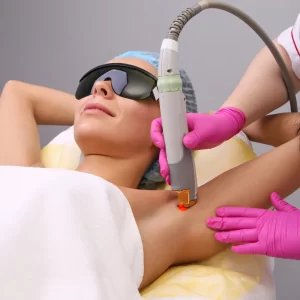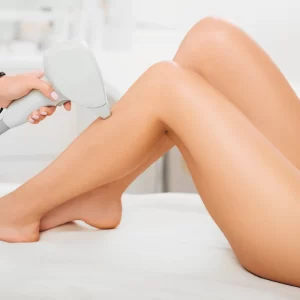Laser hair removal offers a beacon of hope for those seeking to escape the endless cycle of shaving, waxing, and plucking.
Promising long-lasting smoothness, it’s become a go-to solution for unwanted hair.
Yet, many are left pondering the commitment required—specifically, how much time they’ll need to invest in this pursuit of hair-free bliss.
Here’s an enlightening guide to demystify the process, blending our initial insights with the latest findings from reputable sources.
Factors Affecting Treatment Duration
Before diving into specifics, it’s important to understand the factors influencing session duration:
- Treated Area: The size of the area being treated is the most significant factor. Smaller areas like the upper lip take considerably less time than larger areas like the back.
- Hair Growth: Coarse, dense hair requires more laser pulses compared to finer hair, extending treatment time.
- Laser Technology: Different laser systems operate at varying speeds. Newer technologies often boast faster treatment times.
- Technician Experience: A skilled technician can work efficiently while ensuring proper coverage, potentially reducing treatment duration.
Treatment Times by Body Area
Now, let’s delve into the estimated times for laser hair removal treatments on various body areas:
-
Face (15-30 minutes): Facial areas like the upper lip, chin, and cheeks are relatively small, leading to quicker sessions (around 15 minutes). However, a full-face treatment encompassing areas like the sideburns and forehead can take 30 minutes.
-
Neck and Shoulders (20-30 minutes): The neck and shoulders are larger than facial areas, translating to slightly longer sessions (20-30 minutes).
-
Underarms (10-15 minutes): Underarms are a common target area due to their manageable size and fast hair growth cycle. Treatments typically take 10-15 minutes.
-
Back (45-60 minutes): The back is a large area with dense hair growth. Consequently, back hair removal sessions are among the longest, ranging from 45-60 minutes.
-
Chest (30-45 minutes): Similar to the back, the chest is a large area and may require 30-45 minutes for thorough treatment.
-
Arms (15-30 minutes per arm): Arm hair removal depends on the treated area (upper or full arms) and hair density. Upper arms typically take 15 minutes, while full arms can reach 30 minutes per arm.
-
Abdomen (20-30 minutes): The abdomen is a medium-sized area with varying hair density. Treatment times can range from 20-30 minutes.
-
Bikini Line (15-25 minutes): The bikini line can be a sensitive area. Sessions typically last 15-25 minutes, depending on the treated area (full bikini or just the line).
-
Legs (30-60 minutes per leg): Legs are the largest area treated with laser hair removal. Half legs (from knees down) can take 30 minutes, while full legs can reach 60 minutes per leg.
-
Full Body (1-1.5 hours): For those seeking complete hair removal, full-body sessions encompass multiple areas and can take 1-1.5 hours.
Remember, these are just estimates.
The actual duration of your treatment may vary based on the factors mentioned earlier.
It’s crucial to consult with a qualified laser hair removal technician who can assess your individual needs and provide a more precise timeline for your treatment plan.
Beyond Time: Optimizing Your Laser Hair Removal Experience
While treatment duration is essential, achieving optimal results goes beyond just the time spent in the clinic. Here are some additional tips:
- Schedule Consultations: Consult with a licensed and experienced technician who can discuss your goals, assess your skin and hair type, and recommend a suitable laser and treatment plan.
- Follow Pre-Treatment Instructions: These may include avoiding sun exposure, shaving the area, and discontinuing certain medications.
- Maintain Realistic Expectations: Laser hair removal typically requires multiple sessions (often 4-8) spaced several weeks apart for optimal results. Hair growth gradually diminishes with each session.
- Post-Treatment Care: Follow the technician’s aftercare instructions, which may involve applying moisturizer and avoiding sun exposure.
Understanding Laser Technology for Optimal Results
Laser hair removal technologies have advanced significantly over the years, offering more efficient and comfortable options for various skin and hair types.
The two main types of lasers commonly used for hair removal are diode and Alexandrite lasers, each with its unique advantages and suitability for different individuals.
Additionally, newer technologies like the Nd:YAG laser have expanded the options for effectively treating a wider range of skin tones.
Diode Lasers
Wavelengths and Impact: Diode lasers typically operate at a wavelength of around 810 nm.
This mid-range wavelength makes them highly versatile, suitable for treating a broad spectrum of skin tones, from light to medium-dark.
Effectiveness: Diode lasers are particularly effective on coarse hair, making them a popular choice for areas like the bikini line and underarms.
They can target the hair follicle deeply and effectively.
Comfort Levels: Many modern diode laser systems incorporate cooling mechanisms to enhance comfort during treatment, making the experience more bearable for patients.
Potential Side Effects: Common side effects may include skin irritation and redness, although serious complications are rare when performed by a skilled technician.
Diode lasers strike a balance between efficacy and safety for a wide range of hair and skin types.
Alexandrite Lasers
Wavelengths and Impact: Operating at a wavelength of 755 nm, Alexandrite lasers are optimal for lighter skin tones.
This shorter wavelength allows for high melanin absorption, making it effective for lighter skin with dark hair.
Effectiveness: They excel at treating large body areas quickly and are particularly effective on fine to medium-coarse hair.
Comfort Levels: Alexandrite lasers might be slightly less comfortable compared to diode lasers, primarily due to the high melanin absorption rate.
However, many devices come equipped with cooling systems to mitigate discomfort.
Potential Side Effects: The main concerns include a higher risk of pigment changes, especially for those with darker skin tones.
It’s crucial for treatments with Alexandrite lasers to be conducted by experienced professionals, especially when treating near the limits of its suitable skin tone range.
Nd:YAG Lasers
Advantages: The Nd:YAG laser operates at a longer wavelength of 1064 nm, making it suitable for all skin types, including darker skin tones.
Its ability to bypass the melanin in the skin’s surface to target the hair follicle directly reduces the risk of skin pigmentation changes, which is a common concern with other laser types.
Effectiveness: While it is effective for a wide range of skin tones, Nd:YAG lasers are particularly beneficial for individuals with dark skin and coarse hair.
However, it might require more sessions compared to diode and Alexandrite lasers for achieving optimal results.
Comfort Levels: The Nd:YAG laser is associated with a higher level of discomfort compared to diode and Alexandrite lasers, but cooling technologies and pain reduction techniques can help manage this.
Potential Side Effects: Given its deeper penetration and reduced melanin absorption, the Nd:YAG laser has a lower risk of pigment changes, making it safer for darker skin tones.
However, there might be an increased sensation of discomfort and a higher likelihood of minor side effects such as redness and swelling.
Each laser technology offers unique benefits and limitations, making it essential to consult with a skilled laser hair removal technician who can assess your individual needs and recommend the most suitable laser type.
This ensures not only the efficacy of the treatment but also minimizes the potential for side effects, aligning the procedure with your specific hair and skin type for the best possible outcomes.
Embrace Smoothness with Confidence
Laser hair removal offers a long-lasting solution for unwanted hair growth.
By understanding treatment times and factors affecting them, you can approach your laser hair removal journey with confidence.
Remember, open communication with your technician is key to achieving the smooth, hair-free results you desire









